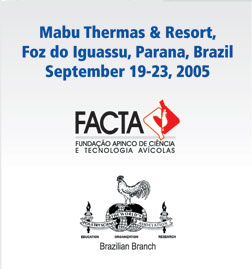Contributed Papers: Oral Presentations
Pathology |
CHICKEN COCCIDIOSIS:
A FRESH LOOK AT LESIONS
R.
B. Williams
Coxitec Consulting, Hertfordshire, UK
E-mail address: ray.coxitec@tesco.net
Macroscopic
coccidial lesions in chickens are usually assessed
by the subjective scoring systems developed by Johnson
& Reid (1970). Johnson & Reid’s system
was developed using naïve birds; the grades correlate
negatively with weight gain or FCR. In immune birds
(drug-treated or vaccinated) lesion scoring can be
misleading because mild lesions may sometimes occur
in birds with normal weight gain or FCR. Furthermore,
any lesions in vaccinated birds that are clinically
protected frequently contain few or no observable
parasites, whereas those in naïve birds are packed
with parasites.
Association of specific pathogens with a parasitic
lesion is not, by definition, a necessity, but may
help with lesion identification. The similarities
in gross appearance of lesions and the differences
between associated parasite burdens in naïve
and immune birds suggest that coccidial lesions are
due more to host responses than to the parasite itself.
The lesions sometimes present in immune birds in the
field are presumably the result of successful repulsion
by the host of a parasite challenge. What, then, accounts
for the gross appearance of lesions; and are there
fundamental differences between those occurring in
naïve and immune birds?
Perhaps in naïve birds, white plaques caused
by Eimeria acervulina or E. necatrix are due to endogenous
parasites (schizonts, gametocytes or oocysts), fibrin
and/or invading leucocytes. Red lesions (E. brunetti,
E. maxima, E. necatrix, E. tenella) may be due to
haemorrhage resulting from rupture of capillaries
or diapedesis. But in immune birds with lesions superficially
similar to those in naïve birds, immunological
responses alone may be responsible for the white lesions,
and inflammation (vasodilatation, hyperaemia, congestion)
may account for the red lesions. But why do E. mitis
and E. praecox not cause gross lesions? Explanations
might be provided by histological and immunological
techniques.
A few commercially-vaccinated birds may develop lesions
directly resulting from vaccination, but attenuated
vaccines do not harm performance. Lesions may also
result later from natural field challenge in some
vaccinated birds, again without affecting their performance.
Clearly, lesion scoring alone under-rates vaccine
efficacy, and should not be used to judge the immune
status of birds, but do lesions in vaccinated birds
damage the gut epithelium? Direct microscopical examination
under physiological saline of the fresh intestinal
mucosa of affected birds facilitates immediate clinical
assessment of their gut integrity, and might provide
the answer.
